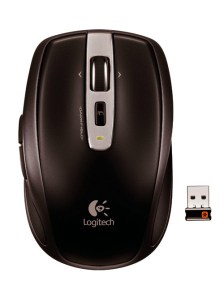 Optical mice typically track in surfaces by detecting bumps, patterns, and other details and using them to track the motion of the device as a user pushes it around; however, these tracking technologies typically can’t handle clear glass and other highly reflective surfaces because they’re so flat, and a bunch of the light the mice use to see details gets reflected back or lost, throwing off the tracking mechanisms. Logitech says its new Darkfield technology uses dark field microscopy to detect particles and tiny scratches and irregularities on surfaces—even glossy surfaces and clear glass at least 4mm thick—and that technology enables their new Anywhere Mouse MX and Performance Mouse MX to work where other mice fail.
Optical mice typically track in surfaces by detecting bumps, patterns, and other details and using them to track the motion of the device as a user pushes it around; however, these tracking technologies typically can’t handle clear glass and other highly reflective surfaces because they’re so flat, and a bunch of the light the mice use to see details gets reflected back or lost, throwing off the tracking mechanisms. Logitech says its new Darkfield technology uses dark field microscopy to detect particles and tiny scratches and irregularities on surfaces—even glossy surfaces and clear glass at least 4mm thick—and that technology enables their new Anywhere Mouse MX and Performance Mouse MX to work where other mice fail.
“Thanks to Logitech Darkfield, whether you’re checking the morning news from the granite counter top in your kitchen or at work manipulating a spreadsheet from your glass desk, you can be confident that your Logitech mouse will be up to the task,” said Logitech senior VP Rory Dooley, in a statement.
The Logitech Anywhere Mouse MX features a conventional mouse shape with a scroll wheel and travel pouch, and offers forward and back buttons under the thumb for simpler Web-surfing. The Performance Mouse MX features a more contoured profile, four customizable thumb buttons, and force-sensitive side-to-side scrolling, along with a microUSB charging system that lets users recharge the mouse using the computer or a wall outlet even while it’s being used. Both mice feature Logitech’s Unifying Receiver that stays in a notebook computer and doesn’t need to be removed for transport—and can be used with other Logitech keyboards and mice.
The Anywhere Mouse MX and Performance Mouse MX should be available this month in the U.S. and Europe for a suggested retail price of $99.99 and $79.99, respectively.
Editors' Recommendations
- This Logitech HD webcam with mic and privacy cover is 26% off
- Does the Vision Pro work with glasses and contacts?
- Samsung has a 3D gaming monitor that doesn’t need glasses — and it actually works
- How to use the Logitech G Hub features for your new gaming peripherals
- These new smart glasses put a 500-nit, 330-inch screen on your eyes


